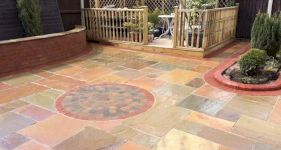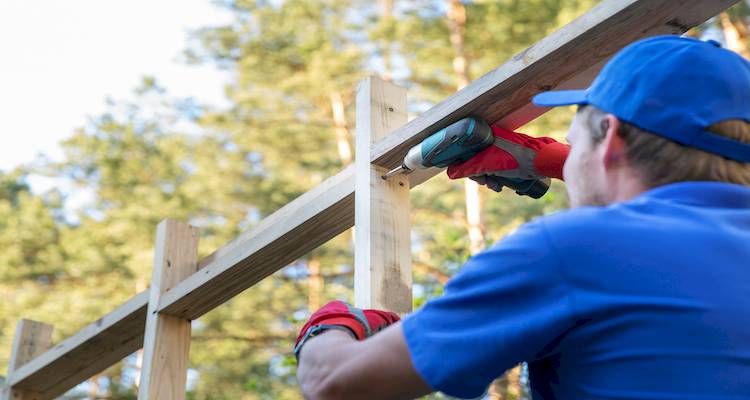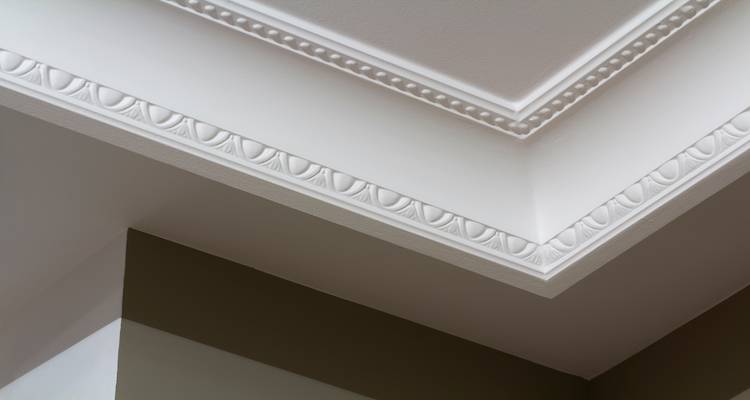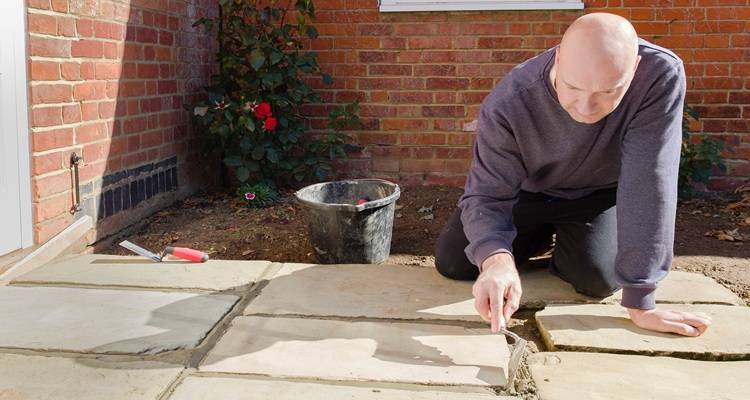Thatched Roof Cost
- The average thatched roof cost is around £20,000 in the UK.
- Installing a thatched roof typically takes between 3 - 6 weeks to complete.
- How much a thatched roof costs to install, that impacts the cost to thatch a roof, and what roof thatchers cost to hire in 2024.
- What's involved in installing or replacing a thatched roof, how long this type of job typically takes to finish, and expert advice from tradespeople on MyJobQuote.
- How to find and hire a thatched roof specialist near you.
How much does a thatched roof cost in the UK?
Thatched roofs are beautiful and unique features that can add a lot of character to a property.
However, they're not as common as they used to be, with less than 1% of houses in the UK having them (many of which are listed).
Thatched roofs are also quite hard to maintain and will typically need to be fully replaced every 15 – 25 years (depending on the material used).
In 2024, the average cost to thatch a roof is between £15,000 – £30,000 in the UK. The exact thatched roof cost you're quoted by a specialist will depend on various factors, though.
Just looking to get a quote?
We've got you covered! MyJobQuote have a range of local thatched roof specialists ready to offer you a free, no obligation quote!
Have a read of our detailed guide below...

£20,000
Table of Contents
- How Much to Thatch a Roof?
- Additional Thatched Roof Costs
- How Much Do Roof Thatchers Cost to Hire?
- What Impacts the Cost of Thatched Roof Installation?
- What's Involved in Thatching a Roof?
- Can I Install a Thatched Roof Myself?
- Building Regulations & Planning Permission for a Thatched Roof Installation
- Benefits of a Thatched Roof Installation
- Checklist: Hiring Contractors to Install a Thatched Roof
- FAQs
- Sources
How Much to Thatch a Roof?
The prices will vary depending on the size of the roof, the design, and the materials used for the roof. In total, you can expect to spend around £15,000 – £30,000 to have a thatched roof installed. However, the prices can vary quite a lot. It's not cheap to install a thatched roof, and it's definitely not a great option for those on a tight budget.
The materials alone can set you back around £8,000 – £12,000 depending on the size of your roof, and the labour costs will usually work out around £100 – £225 per day. Since a thatched roof installation can take a few weeks to complete, you can see how the labour costs for this type of work can easily add up.

I have a thatched roof home that I am now looking to have repaired in a few areas. The majority of the roof is in suitable order, but there are some areas which will need replacing if possible. What are the costs involved in having repairs to a thatched roof?
Average Cost of Thatched Roof Installations
Thatched roof prices you're quoted will depend mostly on the size of your roof.
Below is a table indicating the average costs that you can expect when installing a thatched roof on different-sized properties:
| Size of Roof | Average Price |
|---|---|
| Small thatched roof (55m²) | £4,100 – £11,000 |
| Medium thatched roof (85m²) | £6,250 – £16,600 |
| Large thatched roof (110m²) | £8,400 – £22,250 |
The cost of thatched roof materials has seen a recent increase due to poor harvests in the UK (due to bad weather), as well as geopolitical events that have reduced the availability of materials from outside of the UK.
The cost of hiring a roof thatcher has also increased. This is because there is a growing shortage of qualified tradespeople who can do this work, but also because demand for traditional tradesman (like roof thatchers) has increased in recent years.
Additional Thatched Roof Costs
When it comes to installing a thatched roof, there are several additional costs that you may need to think about. Below is a list of the extra costs that you may need to consider with this type of work:
Roof Insulation Cost
Due to the nature of a thatched roof, it's a good idea to install roof insulation to keep your energy bills down and prevent heat from escaping through the roof.
On average, roof insulation costs around £400 – £600. The overall price will depend mostly on the size of the roof and your location in the UK.
Skip Hire
When installing or replacing a thatched roof, there may be a lot of mess and waste that needs to be disposed of. This is where a skip hire would come in very handy.
The average cost to hire a skip is around £90 – £440 per week. The price will depend on the size of the skip and your location in the UK.
Skylight Installation
Adding a skylight or Velux window to your home can add light into your loft space. This is great for those who have or are planning to have a loft conversion.
The average skylight window cost is between £600 – £3,000. The overall cost will depend on the type of window, the size of the window, and your location in the UK.
If you're looking into thatched roof replacement costs and live in a listed building, then the addition of a skylight would typically not be granted — as it would significantly alter the appearance of the property.

How Much Do Roof Thatchers Cost to Hire?
Let's take a look at labour costs and timescales:
Installing a thatched roof is a difficult job that requires the work of a specialist. You will need to hire someone who is competent and experienced in installing a thatched roof.
A thatched roof specialist will usually charge around £100 – £225 per day and will usually work in a team of at least two. You may also need to pay additional costs to hire scaffolding for the thatcher to work on.
Depending on the size of the roof and the complexity of the job, it can take around 3-6 weeks to install a thatched roof. If you are having your thatched roof replaced, then this will take longer, as the old thatch will need to be removed before the new thatch can be added. This will result in an increase in labour costs.
What Impacts the Cost of Thatched Roof Installation?
There are many things that can affect the cost of installing a thatched roof. Below is a list of the things that may affect the overall cost of the job:
Type of Thatch
There are several different types of thatch that can be used on a roof, and they each come with varied price points. Some examples of thatch types include water reed, Norfolk Reed, Devon reed, longstraw, Heather, or rye straw.
Water reed is the most common type of thatching material; however, it is limited in supply, so it can be quite expensive.
Is it possible to change the material of a thatched roof when it's due for reroofing? (e.g., from straw or wheat to water reed?)
Roof Size and Design
The size of the roof is the biggest factor that can affect the cost of your thatched roof installation. The larger your roof is, the more you can expect to pay for your thatched roof.
Larger roofs will not only require more materials, but they will also take much longer to complete; therefore, the labour costs will also be higher.
Scaffolding Cost
Many thatched roof contractors will include the cost of scaffolding in the overall job quote they give to you. However, sometimes this will be an additional cost.
The overall cost of hiring scaffolding will depend on the length of time that it is needed. The average cost to hire scaffolding is around £950 – £1,150 per week.

Waste Removal Cost
Many contractors will include the cost of waste removal within the quote for the job. However, in some cases, this may be an additional cost that you need to think about.
The average cost to hire a skip is around £90 – £440 per week. The price will depend on the size of the skip and your location in the UK.
Location in the UK
Your location can play a part in how much you will pay for installing a thatched roof. This is due to the increased cost of labour for certain areas. Those based in and around London can expect to pay more labour costs than those in northern England.
What's Involved in Thatching a Roof?
Installing a thatched roof is quite an extensive and difficult job to complete. It is a job that requires a specialist who has experience in installing this type of roof.
You may be wondering what the job entails. To help you understand what's involved with a thatched roof installation, we have created the list below of all of the steps involved with installing this type of roof:
- Build the roof structure for the thatching by nailing a 2x4 inch piece of lumber from all four corners of the building up to a centre ridge pole that runs parallel to the ground.
- Tie the four corner pieces together by nailing in cross members that extend from each corner. Ensure that these are parallel to the ridge pole and that they are 24 inches apart.
- Obtain your dried reeds ready for thatching. The best type of reeds are harvested during the winter months as standing dead material. This ensures that the reed is completely dry and ready.
- Gather the reeds together into bundles of around 8 inches in diameter and twist the tops to hold them together.
- Start at the bottom corner on one side of the roof and use wire and pliers to wire one bunch of reeds at a time to the cross members.
- Continue this process across the entire cross member and make sure you leave minimal space between each of the thatch bunches.
- Continue doing this all the way to the ridge pole, and make sure you overlap each upper layer of thatching at least halfway down the lower layer of thatch.
Are materials for thatching a roof sourced in the UK? If so, who supplies them?
Can I Install a Thatched Roof Myself?
When installing a thatched roof, it is never recommended that you do it as a DIY project. It is difficult to complete and can take over a month to finish – even by professionals.
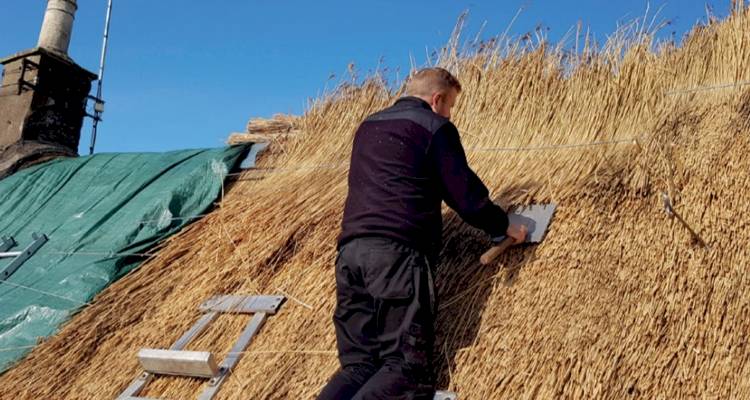
You should hire a thatched roof specialist who has experience installing the type of thatched roof you want. The roof is a very important part of your property, so it must be installed correctly by a professional.
There are also several building regulations that apply to installing a roof, so it's a good idea to choose a professional company to carry out the work so that you can ensure everything is done safely.
Is netting or wire mesh better to cover a thatch roof with? Or does it depend on what your thatch material is?
Building Regulations & Planning Permission for a Thatched Roof Installation
When installing a thatched roof on your property, you may or may not need to worry about planning permission. In some cases, you will definitely need planning permission, for example, if you alter your roof's height.
Below are some of the conditions in which you may need to apply for planning permission:
- If you are planning structural changes to the roof
- If your new roof materials will react differently in a fire to your current roofing materials
- If your new roof will project 150 millimetres from the existing roof plane
- If you are changing the material of your roof
- If you are moving insulation that will need to be replaced
- If you are installing a roof light as part of the new roof
If you are unsure whether your new roof may require planning permission, you can find out more information on the Planning Portal website, or you may want to get in touch with your local authority for some advice.
Your new thatched roof will also have to adhere to building regulations rules. These rules are put in place to ensure the roof is safe for you and your family. When you hire a thatched roof specialist, they should have the knowledge required to ensure that all of the work carried out adheres to the building regulations.
How can I find out if I am living in a listed building? Should I contact my local council or is there another authority I need to get in touch with?
Benefits of a Thatched Roof Installation
There are many benefits to choosing a thatched roof for your property. Below is a list of the advantages that come with having this type of roof:

- Aesthetically pleasing — A thatched roof is a very unique feature of a home. There are not many thatched roof properties left in the UK, so they're a real talking point.
- Durable — Thatched roofs are very durable and can last for many years. Although your roof ridge will need to be replaced regularly, the materials are very long-lasting.
- Insulating — Thatch is naturally very insulating, so it can help to keep your house cool in the summer and warm in the winter. This can help to reduce your energy bills.
- Sustainability — The materials needed for thatching are sustainable and environmentally friendly.
- Lightweight — Thatching materials are light and won't require the heavy supports that other roof types need. This can help to lower costs.
Checklist: Hiring Contractors to Install a Thatched Roof
You will need to consider a few things before hiring contractors to install a thatched roof for you.
Below is a list of some of the main things that you should consider when looking for the right contractors for the job:
- Does the contractor offer any guarantees with their work?
- How much is the work to complete? – Ask for a breakdown of costs so you can ensure you are paying a good price for each element of the job.
- Is the contractor experienced in installing the type of thatched roof that you want?
- How many years' worth of experience does the contractor have in installing thatched roofs.
- How many contractors will carry out the job?
- Will the contractor fix any issues that may arise?
- Will the contractor take care of any relevant waste removal?
- Do you need to hire any additional contractors for different parts of the work?
- Will the contractor follow all of the relevant building regulation guidelines?

FAQs
How long does a thatched roof last?
What is a thatched roof made of?
Do I need specialist home insurance to cover a thatched roof?
Does a thatched roof need ventilation?
Do I need to install gutters with my thatched roof?
How many thatched properties are there in the UK?
The majority of these houses (about 75%) are listed buildings, which require the like-for-like replacement of housing features (like thatched roofs) so that its appearance does not change.
How do I maintain my thatched roof?
- Clean the roof regularly and remove all moss and leaves with a rake.
- Cut back any overhanging trees that may touch the thatched roof and cause damage. Also, cut trees back regularly as the roof will be prone to damp if it is constantly in the shade.
- Spray the roof with a liquid to prevent moss and algae.
- Repair any holes that may occur due to birds or other animals.
- Keep an eye on the condition of the ridge and flashings and have these replaced every 8-10 years.
Sources
https://www.planningportal.co.uk/permission/common-projects/roof/roof-planning-permission
https://www.dailymail.co.uk/news/article-13656439/thatched-cottages-threat-war-Ukraine-machinery-weather.html
https://www.engineshed.scot/building-advice/building-components/roofs/thatched-roofs/
https://www.surewise.com/home-insurance/articles/pros-and-cons-of-thatched-roofs/
https://www.insurancechoice.co.uk/blog/2019/11/maintaining-and-repairing-a-thatched-roof
https://www.nimblefins.co.uk/home-insurance-thatched-roof-property
https://www.savills.co.uk/blog/article/277325/residential-property/in-praise-of-thatched-properties.aspx
https://www.theottohouse.com/blog/living-with-a-thatched-roof-the-pros-and-cons


